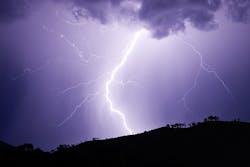Need for Quality Control for Lightning Protection Emphasized by Industry Experts
A diverse group of lightning protection experts, engineers and safety directors recently met at the 82nd annual LPI/ULPA Lightning Protection Conference in Singer Island, Fla., to review industry developments in technology, best practices and public awareness initiatives. Representatives from the LPI-IP Inspection Program, Underwriters Laboratories (UL), and the NFPA Technical Committee on Lightning Protection weighed in on a variety of industry issues, but "quality control" was a central theme that dominated conference discussions.
"The need for quality control is not a new concept, but concerns about quality control are increasing," said Bud VanSickle, executive director for the Lightning Protection Institute (LPI). "A trend is developing with outside trades like electrical and roofing contractors attempting to grow their business by dabbling in lightning protection installation. This is a problem, as lightning protection specifications call for installation in accordance with national safety standards (NFPA 780 and UL 96/96A), UL-listed materials and work performed by LPI-certified lightning protection specialists," explained VanSickle.
The International Association of Electrical Inspectors (IAEI) reiterates the importance of LPI-certified and UL listed installers for lightning protection applications. IAEI devoted a new chapter called "The Fundamentals of Lightning Protection" to its 10th edition of the "Soares Book on Grounding and Bonding" in 2008, which was updated and expanded in the 11th edition, released in 2011. The handbook now includes a reminder to electrical contractors that "installation of a lightning protection system is much different from the installation of electrical service wiring."
According to the Soares handbook: "specialized material and installation methods such as that specified in NFPA 780 and UL 96 are required and the system should only be installed by qualified personnel trained and certified in the installation of lightning protection systems."
Issues regarding counterfeit and fraudulent third party inspections can be of special concern for lightning protection quality assurance, as well.
UL senior project engineer, Eric Boettcher, shared information with conference attendees about UL's "Market Surveillance Group" which investigates fraudulent violations pertaining to third party inspections of lightning protection. According to Boettcher, UL has an "aggressive stance against counterfeiting" to promote quality control in the marketplace.
"Lightning can generate up to 200kA of electric energy, so quality control for lightning protection is crucial," added VanSickle. "The experienced and certified lightning protection specialist will know how to interpret the safety standards, as well as provide the proper third-party inspection requirements for quality assurance closeout."
